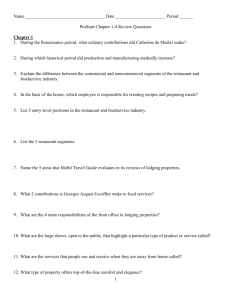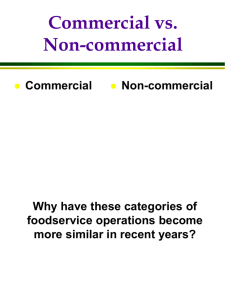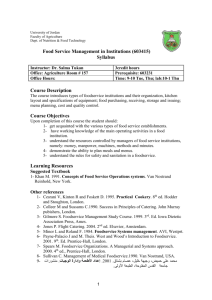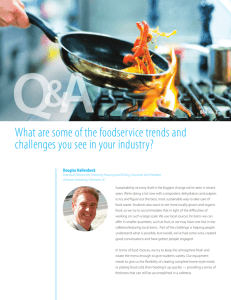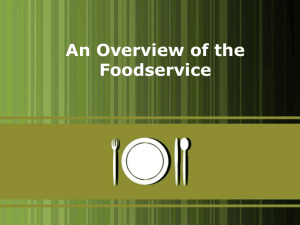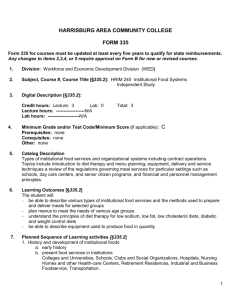Foodservice Industry - Houston Independent School District
advertisement
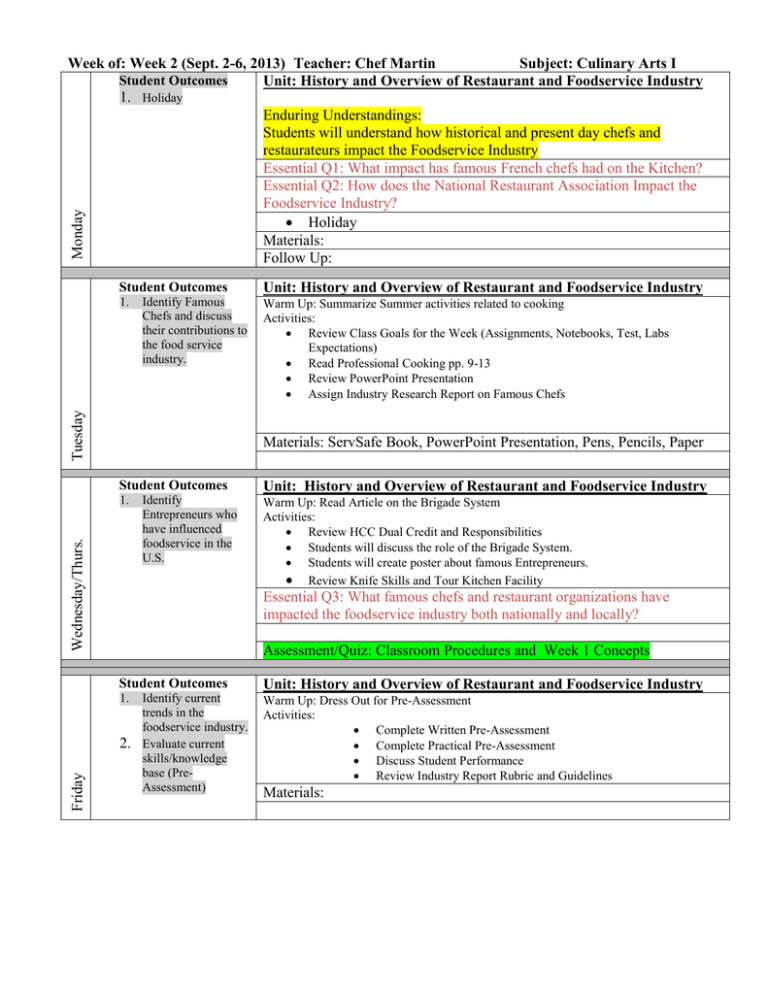
Monday Week of: Week 2 (Sept. 2-6, 2013) Teacher: Chef Martin Subject: Culinary Arts I Student Outcomes Unit: History and Overview of Restaurant and Foodservice Industry 1. Holiday Enduring Understandings: Students will understand how historical and present day chefs and restaurateurs impact the Foodservice Industry Essential Q1: What impact has famous French chefs had on the Kitchen? Essential Q2: How does the National Restaurant Association Impact the Foodservice Industry? Holiday Materials: Follow Up: Student Outcomes Unit: History and Overview of Restaurant and Foodservice Industry 1. Warm Up: Summarize Summer activities related to cooking Activities: Review Class Goals for the Week (Assignments, Notebooks, Test, Labs Expectations) Read Professional Cooking pp. 9-13 Review PowerPoint Presentation Assign Industry Research Report on Famous Chefs Tuesday Identify Famous Chefs and discuss their contributions to the food service industry. Materials: ServSafe Book, PowerPoint Presentation, Pens, Pencils, Paper Unit: History and Overview of Restaurant and Foodservice Industry 1. Warm Up: Read Article on the Brigade System Activities: Review HCC Dual Credit and Responsibilities Students will discuss the role of the Brigade System. Students will create poster about famous Entrepreneurs. Review Knife Skills and Tour Kitchen Facility Wednesday/Thurs. Student Outcomes Essential Q3: What famous chefs and restaurant organizations have impacted the foodservice industry both nationally and locally? Assessment/Quiz: Classroom Procedures and Week 1 Concepts Student Outcomes Unit: History and Overview of Restaurant and Foodservice Industry 1. Warm Up: Dress Out for Pre-Assessment Activities: Complete Written Pre-Assessment Complete Practical Pre-Assessment Discuss Student Performance Review Industry Report Rubric and Guidelines 2. Friday Identify Entrepreneurs who have influenced foodservice in the U.S. Identify current trends in the foodservice industry. Evaluate current skills/knowledge base (PreAssessment) Materials: Career Preparation: Overview of the Foodservice Industry Length of Class: Class Duration: 1 session 90 minutes Lecture: Student Activity: Optional Quiz: 70 minutes 20 minutes 10 minutes Student Objectives: Accurately describe the traditional job positions and duties for the back of the house Accurately describe the traditional job positions for the beverage department and front of the house Accurately describe the job opportunities and scope of duties for administrative and support personnel List and describe at least four non-traditional foodservice-related careers Discuss the value of using a restaurant as a model business for developing universal business skills TEKS Alignment: Food Production Management & Services: (1)(A); (2)(A); (3)(A),(C),(F); (10) (A),(B),(E); (11)(A),(B); (12)(G); (13)(A),(B),(C),(D),(E),(F); (14)(A) Introduction to Culinary Arts (1)(A),(B),(C),(D); (6)(A),(B),(C),(D),(E) Culinary Arts I (1)(A),(B),(C),(D); (4)(C); (5)(A),(M); (6)(C) Culinary Arts II (2)(A); (3)(B); Foodservice Prep Texas Restaurant Association Education Foundation Career Preparation: Overview of the Foodservice Industry Lecture Guide: I. Introduction: Why a culinary class? A. To create a culinary-focused learning program that will integrate portions of the existing secondary education with a realistic foodservice business laboratory 1. All components of this program are designed to complement other departments and programs within the school and enhance the total learning experience. 2. This program is designed to provide a culinary educational opportunity in which to apply what is learned to a real business environment. B. To create a specialized culinary curriculum that will fit seamlessly with and complement the goals and objectives of local/state/federal secondary education requirements and guidelines C. To prepare the student for a post-secondary foodservice education D. To provide the student with the minimum knowledge, competencies and skill sets to start a successful culinary career in a rapidly growing industry II. Workplace guidelines: Year one See: Becoming a Foodservice Professional, Year 1, 2nd Edition, Intro, pp. 7-8 A. Attendance B. Teamwork C. Punctuality D. Dependability E. Fairness and honesty F. Open and effective communication G. Mutual respect and observance of protocol See: Professional Cooking, 6th Edition, pp. 9-13 H. Acceptance of personal responsibility and accountability I. Commitment to meeting minimum standards III. Traditional career opportunities in foodservice (American) A. Operations 1. Back of the house (BOH) a. Steward b. Pantry/prep c. Line cook d. Roundsman e. Sous chef f. Executive chef/kitchen manager g. Corporate executive chef h. Independent chef/owner 2. Front of the house (FOH) a. Busperson b. Runner/backwaiter c. Waitstaff/frontwaiter d. Cashier/greeter e. Wine steward/sommelier f. Dining room manager/maître d’hôtel g. Corporate service trainer B. Administrative and support positions 1. Administrative a. Office support/coordinator b. Assistant manager c. General/unit manager d. District/regional manager e. V.P. operations f. Independent restaurant owner 2. Support a. Accounting b. Bookkeeping c. Human resources d. Sales e. Catering IV. Non-traditional opportunities See: Becoming a Foodservice Professional, Year 1, 2nd Edition, Intro, pp. 9-17 A. Independent consulting B. Foodservice employment services C. Home economists D. Research and development chefs E. Food styling F. Teaching and professional training G. Personal chef H. Foodservice writing I. Quality assurance J. Foodservice marketing, advertising and sales K. Food science and retail product development L. Crossover opportunities to grocery, HMR, QSR, catering M. Cruise lines, hotels, country clubs and resorts Reading Assignment: Becoming a Foodservice Professional, Year 1, 2nd Edition, NRAEF, Intro, pp. 7-8 and Intro, pp. 9-17. Professional Cooking, 6th Edition, Wayne Gisslen, Chapter 1, pp. 9-13 Recommended Video and Visual Aids: Instructor-provided restaurant organizational chart and overhead of classic Brigade system (Chapter 1, pp. 9-13, Professional Cooking, 6th Edition, Wayne Gisslen). 10 Good Reasons for a Career in Foodservice video, TRAEF.
